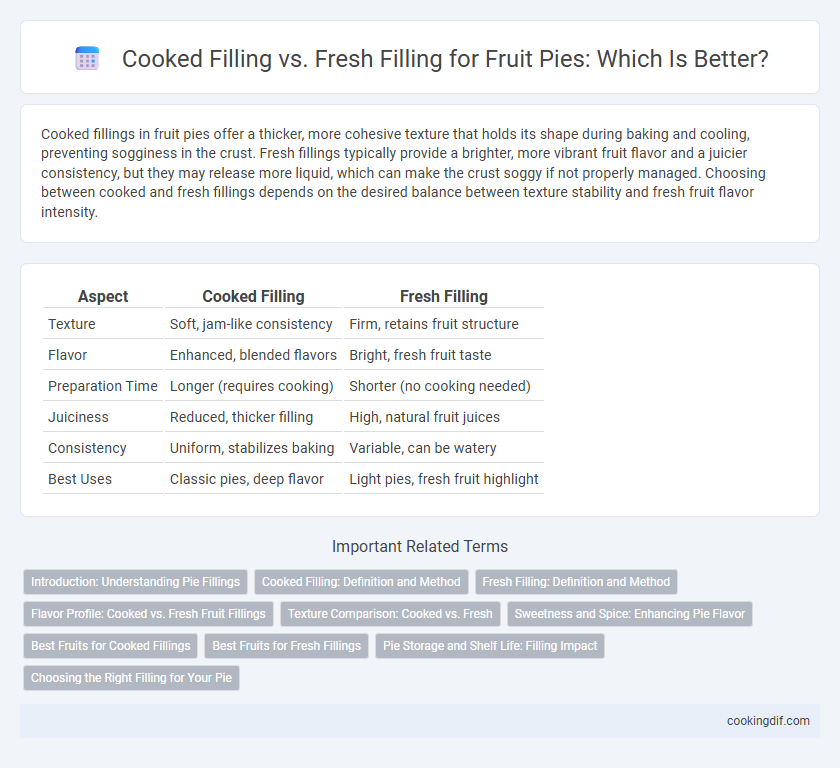Cooked fillings in fruit pies offer a thicker, more cohesive texture that holds its shape during baking and cooling, preventing sogginess in the crust. Fresh fillings typically provide a brighter, more vibrant fruit flavor and a juicier consistency, but they may release more liquid, which can make the crust soggy if not properly managed. Choosing between cooked and fresh fillings depends on the desired balance between texture stability and fresh fruit flavor intensity.
Table of Comparison
| Aspect | Cooked Filling | Fresh Filling |
|---|---|---|
| Texture | Soft, jam-like consistency | Firm, retains fruit structure |
| Flavor | Enhanced, blended flavors | Bright, fresh fruit taste |
| Preparation Time | Longer (requires cooking) | Shorter (no cooking needed) |
| Juiciness | Reduced, thicker filling | High, natural fruit juices |
| Consistency | Uniform, stabilizes baking | Variable, can be watery |
| Best Uses | Classic pies, deep flavor | Light pies, fresh fruit highlight |
Introduction: Understanding Pie Fillings
Cooked fruit pie fillings offer a deeper, caramelized flavor and a thicker, more stable texture than fresh fillings, which often remain juicier and more vibrant in taste but can result in a runnier pie. Cooked fillings undergo a heating process that softens fruit and activates natural pectins, enhancing consistency and longevity during baking. Fresh fillings rely on natural fruit sugars and juices that maintain brightness yet may require thickening agents for an ideal pie structure.
Cooked Filling: Definition and Method
Cooked filling in fruit pies refers to fruit that is partially or fully cooked before being placed into the pie crust, enhancing flavor and controlling moisture content. The method involves simmering fruits with sugar, spices, and sometimes thickening agents like cornstarch or tapioca until the mixture thickens and achieves a desired consistency. This technique prevents a soggy crust and ensures a well-set filling that maintains its shape after baking.
Fresh Filling: Definition and Method
Fresh filling in fruit pies consists of raw, uncooked fruit combined with sugar, spices, and sometimes thickeners like cornstarch or tapioca. This method allows the fruit to release its natural juices and maintain a bright, fresh flavor during baking. Often preferred for pies with firmer fruits such as apples or berries, fresh filling requires precise balance to avoid soggy crusts and ensure proper thickening as the pie bakes.
Flavor Profile: Cooked vs. Fresh Fruit Fillings
Cooked fruit fillings in pies develop a deeper, richer flavor due to the caramelization of sugars and the breakdown of fruit fibers, resulting in a sweeter and more concentrated taste. Fresh fruit fillings offer a brighter, more vibrant flavor with a natural tartness that highlights the fruit's original freshness. The choice between cooked and fresh fillings significantly impacts the pie's overall flavor profile, balancing between intense richness and crisp, refreshing notes.
Texture Comparison: Cooked vs. Fresh
Cooked filling in fruit pies offers a softer, more cohesive texture as heat breaks down fruit fibers and releases natural pectins, creating a smooth consistency. Fresh filling provides a crisp, firmer bite with a more pronounced fruit texture, retaining the integrity of each piece. Texture preference depends on whether a tender, jam-like filling or a fresh, chunky mouthfeel is desired in the pie.
Sweetness and Spice: Enhancing Pie Flavor
Cooked filling in fruit pies intensifies sweetness as heat breaks down fruit sugars, creating a richer, caramelized flavor that balances well with spices like cinnamon and nutmeg. Fresh filling retains a bright, natural sweetness and crisp texture, allowing spices to stand out without overpowering the fruit's inherent tartness. Optimizing pie flavor involves choosing cooked filling for depth and warmth or fresh filling for vibrant, pure fruit taste enhanced by subtle spice notes.
Best Fruits for Cooked Fillings
Cooked fillings for fruit pies often enhance the natural sweetness and create a thicker, more cohesive texture ideal for baking. Best fruits for cooked fillings include apples, pears, and stone fruits like peaches and plums due to their firm structure and ability to soften without becoming mushy. These fruits release water during cooking, which combines with thickeners like cornstarch or tapioca to create a smooth, flavorful filling that holds its shape.
Best Fruits for Fresh Fillings
Best fruits for fresh fillings in fruit pies include berries, apples, peaches, and cherries due to their natural juiciness and balanced sweetness that enhance texture and flavor without extended cooking. Fresh fillings preserve vibrant color and bright, tangy flavors, creating a more aromatic and visually appealing pie. Cooked fillings, while smoother and softer, can diminish fruit brightness and often require added thickeners to maintain consistency.
Pie Storage and Shelf Life: Filling Impact
Cooked fruit pie fillings create a thicker consistency that reduces moisture migration, enhancing pie storage stability and extending shelf life up to 5-7 days refrigerated. Fresh fruit fillings retain higher water content, increasing the risk of soggy crusts and shortening shelf life to approximately 2-3 days under refrigeration. Proper sealing and temperature control are crucial to maintaining quality regardless of filling type.
Choosing the Right Filling for Your Pie
Cooked filling for fruit pies offers a thick, stable texture that prevents sogginess and ensures even heat distribution during baking, ideal for peaches and apples. Fresh filling retains bright, natural flavors and vibrant colors, perfect for berries and delicate fruits that cook quickly and release less juice. Selecting the right filling depends on the fruit's water content and the desired pie consistency to achieve optimal taste and presentation.
Cooked filling vs fresh filling for fruit pies Infographic

 cookingdif.com
cookingdif.com